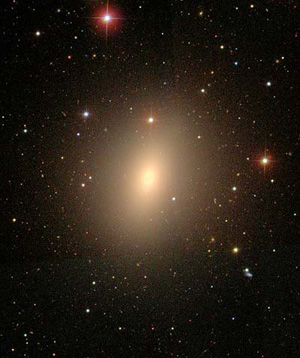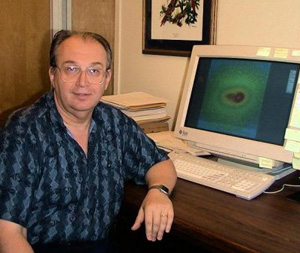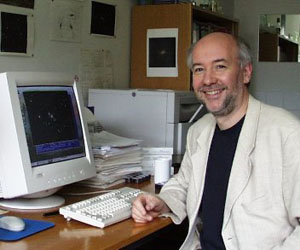New observations from a collection of powerful telescopes have allowed astronomers from Germany and the US to settle a paradox regarding the behaviour of merging elliptical galaxies. The team has revealed evidence that the largest, most massive galaxies in the universe and the supermassive black holes at their cores grow together rather than one leading to the other, which explains the fluffy nature of their central regions.
Astronomers have known for many years that galaxies, containing billions of stars can grow as they absorb and merge with their neighbours. What was unclear though was the relationship between the supermassive black hole at the core of elliptical galaxies, and the growth of such a galaxy.

The elliptical galaxy NGC 4621 (Credit: WikiSky/SDSS)
Initially, astronomers assumed that the huge gravitational fields of such black holes would greedily pull all galactic matter in towards them creating a relatively small, dense cluster at the centre. In the 1980s observations revealed the opposite. The biggest galaxies have huge fluffy, low-density centres.
The best theory to explain this contrary behaviour of supermassive binary black holes was the slingshot effect now observed by Kormendy and Bender. The popular theory of such galactic mergers and acquisitions has it that as two supermassive galaxies collide, their central black holes begin orbiting each other, whisking up the cores of the merged galaxy and flinging stars out of the central region. As the black hole pair sinks to the centre of the merger to form an even more supermassive black hole, the local region should appear depleted of stars.

John Kormendy
Now, Ralf Bender of Germany’s Max-Planck-Institute for Extraterrestrial Physics and Ludwig Maximilians University Observatory together with John Kormendy of the University of Texas at Austin, have published details of their findings in the latest issue of Astrophysical Journal Letters. The team analysed data from Austin’s McDonald Observatory, the Hubble Space Telescope and many other telescopes around the world for 11 supermassive elliptical galaxies in the Virgo Cluster. They measured the dimming of the galactic core due to the stellar depletion, the so-called light deficit.

Ralf Bender
Finding evidence for light deficits in galactic cores is quite surprising, despite being founded on recent decades of new theory and observation by many astronomers, including Kormendy and Bender. The biggest elliptical galaxies contain enormous black holes with masses a billion or more times the mass of our Sun.
Our new observations are a strong and direct link between black holes and galaxy central properties, Kormendy explains, They are a ‘smoking gun’ that connects black holes with the formation of the surprisingly fluffy centres of giant elliptical galaxies.
The fluffiness also increases in lockstep with another galaxy property that is known to be tied directly to black holes, namely the speeds at which stars move far out in the galaxy where they cannot feel the black hole’s gravity.
Astronomers love tight correlations, Bender says. They tell us what is connected with what. The new observations give us much stronger evidence that black holes control galaxy formation, at least at their centres.
Further reading
Astrophys. J. Lett., 2009, in press
http://dx.doi.org/10.1088/0004-637X/691/2/L142
John Kormendy homepage
http://chandra.as.utexas.edu/~kormendy/kormendy.html
McDonald Observatory
http://mcdonaldobservatory.org/
Suggested searches
black holes
galaxies